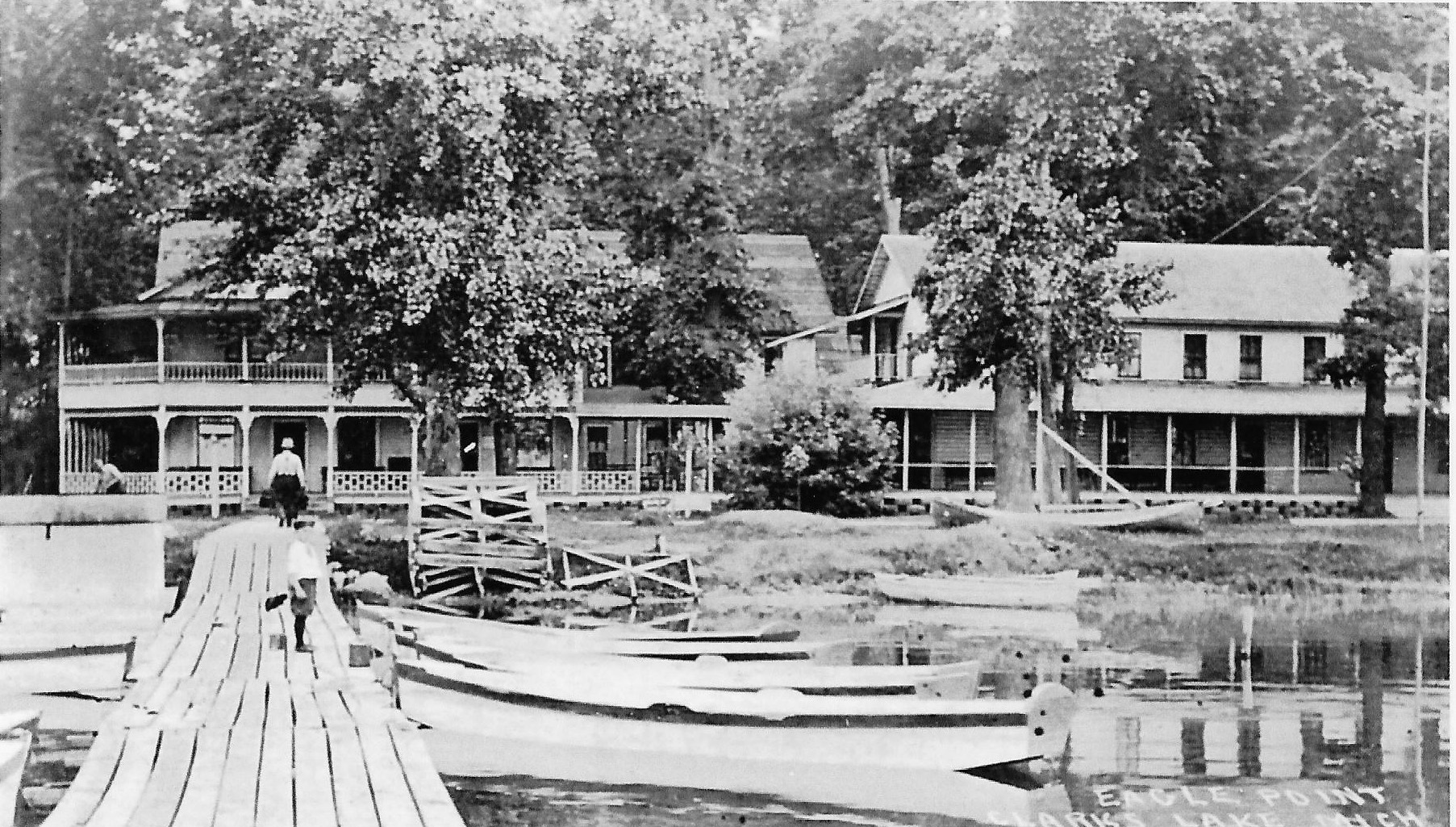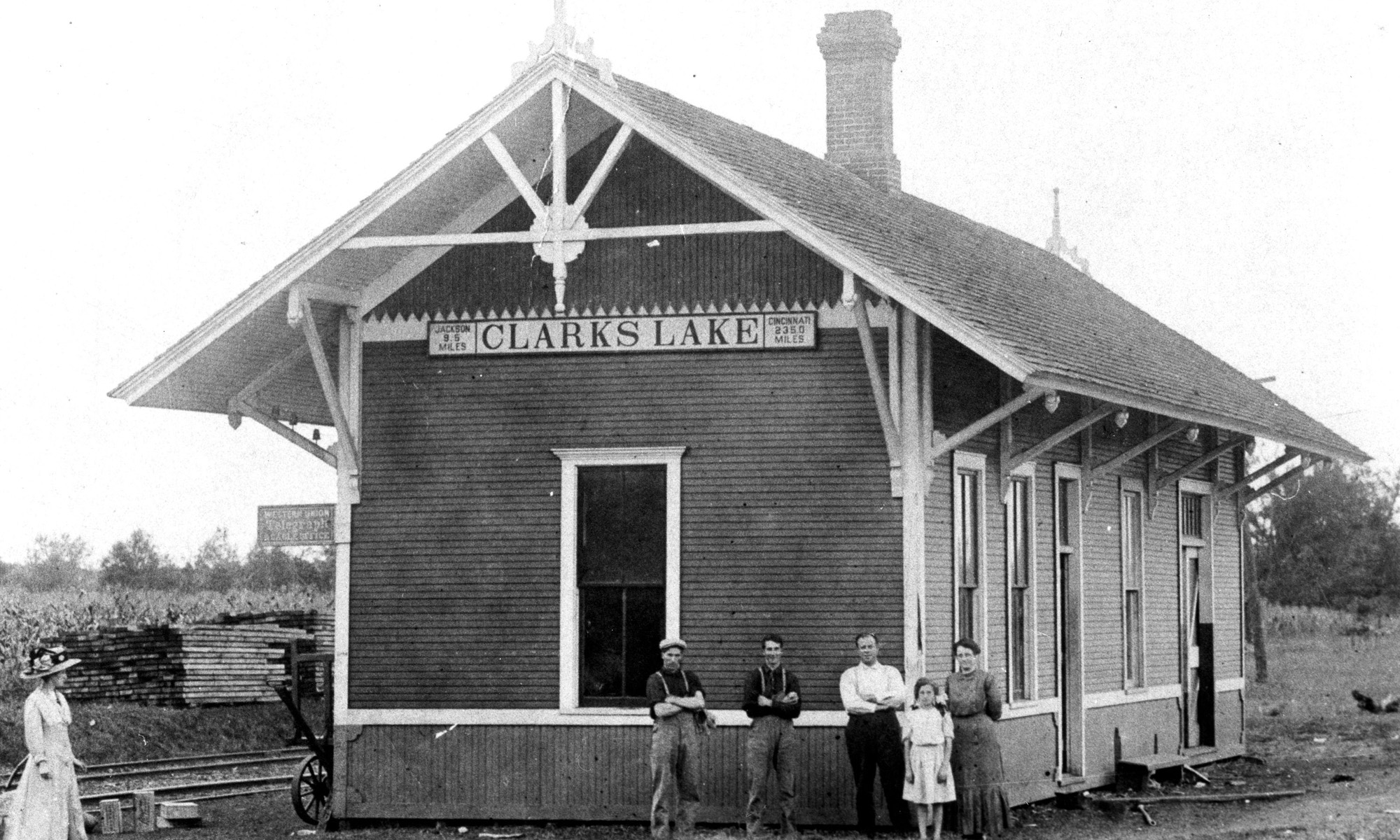by Bill Leutz
As happens from time to time, I was recently discussing the history of Clark’s Lake with a friend, and got to reminiscing of the traditions that used to define our summer stays at the lake. For my family, those early traditions were associated with Eagle Point and its old Hotel. For others it could have been Pleasant View, Ocean Beach, the North Bay, or any one of the other Clark’s Lake areas. For in those days of 14–foot aluminum runabouts with 7 ½ or 10 horsepower outboards, our lake world was the open water or the shoreline on which we lived.
The original structure on Eagle Point was a tavern and inn on the northwest shore. Known as the Eagle Point House, it was built by John DeLameter some 140 years ago – possibly as early as 1872. Shortly after the opening of the Cincinnati Northern Railroad depot on the west end of the lake in 1896, DeLameter built a new structure, called the Eagle Point Hotel. This was set back a little from the shore, near the old tavern. When my grandparents from Toledo visited there in 1903, they would have stayed in the Hotel and dined at the tavern. The Pleasant View Hotel, built by Thomas Beech in 1891, stood across the lake. These two hotels were the center of the growing activity on Clark’s Lake in the early twentieth century.
Before the railroad arrived in 1893, DeLameter platted the Eagle Point subdivision. It was the first such development on Clark’s Lake; more were to come. Soon, The hotel owners built cottages along the shore to accommodate the ever-increasing supply of summer visitors that were regularly arriving on the train from as far away as Northern Kentucky. Passengers from the train could cross the lake to their destinations by a steam launch that debarked from a pier on the west shore, just a short walk from the depot. Road access was difficult in those pre-Model T days, usually by horse-drawn carriage from nearby Jackson.
Visitors in the cottages still looked to the hotels as their actual destinations, and usually dined there. There were well kept walkways, between the cottages and the lakeshore that allowed the passage of guests to and from the hotel. Evening promenades along these lakeside paths were a regular feature of lake life – enjoyed by many and accepted by all. When you stayed in one of the cottages, your visitors arrived via these paths or by boat. The lake was always the important feature. Therefore the front of the cottage was the one with the lakeside view. Kitchen doors were near the road, for easy transfer of supplies – thus the roadside was the back of the cottage.
Even as customers for the hotels waned in the early 1950’s, the old traditions still existed. The old cottages still kept the same tradition also. We were friends of our neighbors from the day we arrived to the day our vacation was over; and regular correspondents long after that. I remember many rainy days of card games with visitors from Kentucky whom I only saw for a week every few years – Hearts and Euchre for the children, Bridge and Canasta for the adults, Pit for the entire family. We still walked the shore paths, and when we visited our neighbors we arrived at the front door – the lakeside door.
For one like myself, whose brightest memories of Clark’s Lake span a period from 1950 through 1968, the effects of changing times seem pronounced. As more people chose to live here permanently rather than for a week or two, city customs arrived with them. Some people who moved here for the beauty of the lake forgot the congeniality of it. Under this influence, the lakeshore has begun to be viewed by some as their backyard —like a private pool that has to be shared, sometimes grudgingly, with other visitors at the lake. I have heard people complain if a pontoon boat (called a raft at Clark’s Lake) moves into their “private” view of the sunset.
We are blessed at Clark’s Lake with the fact that so many of us have lake roots that reach down through four to six generations. The old neighborhoods that once were so limited as to be just the east side of Eagle Point, for example, have expanded to the degree that our neighborhood today is the entire lake. We have the volunteer-supported Thomas R. Collins Memorial Trail, known to most as the Clark Lake Spirit Trail. This follows the back roads around the lake, and allows us to maintain regular contact with many more of our neighbors. That we remember those earlier times through tinted glasses is certain. Still, there are days when some of the congeniality that we grew up with seems to have been lost. As we celebrate the many things we have to share here, let us seek to restore that friendly warmth of a lake life that used to be, and that still struggles to survive.















